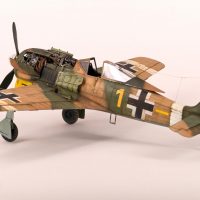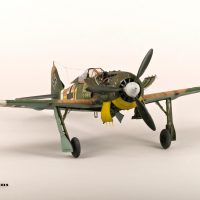Focke-Wulf 190 A-4, 6.JG2 Yellow 1 Erich Rudorffer, Tunisia 1943
Hello modelling mates!
I just finished this longer than usual project. Is the fantastic Fw190 A-4 Eduard 1/48th kit with some aftermarket details. Eduard's Advanced Brassin set including resin engine & fuselage guns, resin wing root gun bays, resin propeller and PE upgrade set. Master Models gun barrels, HGW Models fabric German fighter seatbelts and decals, Quinta Studio 3D decals cockpit set, and Aires resin inspection panel on the vertical stabilizer.
For the colour scheme, I wanted to do something different from the usual ones that we see in the Fw190 so I've opted for this very attractive North African camouflage.

It was flown by Erich Rudorffer in Tunisia in 1943
Considered by many to be the Luftwaffe's greatest all-round fighter ace of World War Two, Erich Rudorffer served on every major front, flew all of the classic German fighters and was renowned for his ability to shoot down multiple aircraft in succession.
Beginning his campaign with JG2 during the Battle of France, Rudorffer then served in the Battle of Britain alongside top aces such as Helmut Wick and Gunther Seeger. Flying the Bf109E, his aerial victories soon mounted, and he continued to joust with the RAF during the 'Non-stop' offences of 1941.
By the time of the ill-fated Dieppe Raid in 1942, Rudorffer scored his 44th and 45th victories, both Spitfires. His Gruppe was then relocated to northern Africa where the war was going badly for the Axis forces. Now flying the heavily-armed Fw190, he began to demonstrate his skill at downing a number of aircraft on a single sortie. On the 9th February 1943, he claimed eight British aircraft and a short time later scored multiple victories over US-flown fighters.

By June of the same year, Erich had moved to the brutal Eastern Front, assuming command of II/JG54, the famous ‘Green Hearts', and continued to display his remarkable ability. On the 6th November 1943, he tangled with a large force of Soviet aircraft and shot down no fewer than thirteen of them, a record for a single mission. By this time Rudorffer had already been awarded the Knight's Cross with Oak Leaves and in January 1945 ‘Swords' were awarded to this decoration after achieving his 212th victory.
Shortly after, he was given the command of I/JG7, flying the potent Me262 jet fighter in the defence of Germany. Despite the dreadful war situation, lack of fuel, marauding Allied fighters over the jet airfields and heavily outnumbered in the air, he managed to shoot down a further twelve aircraft with the Me262. By the war's end, Erich Rudorffer had flown more than 1000 sorties, scored 224 victories and was the seventh-highest Ace in the history of aerial combat.
He died at the age of 98, on the 8 of April 2016.



















I “liked” on the other forum and I like your Wurger here also, nice work, specially the engine
Gracias Pedro! ?
Wow! Just, wow!
Thank you!...
... just Thank you ?
Very well done, love the scheme
Thank you, George! yeah, I like it too!
Fantastic build, Jorge.
Details on the engine are awesome.
Also the desert scheme looks great on this 190.
Absolutely 'Liked'.
Thanks! Yeah, the engine adds a lot of focal interest. And that scheme is very cool in my opinion.. ?
Lovely build Jorge.
Thank you, Happy you liked it ?
Excellent build, Jorge!
Loved the story of Erich Rudorffer, as well!
Thank you very much, Spiros! Yeah he was a pretty cool and not so known ace!
I have to admit, until tonight, I had spent a long time being puzzled about "Erich Rudorffer's Fw-190 in North Africa," because there are three different schemes - the European 74/75/76, the 78/79 scheme, and this scheme. My problem had been, how - with the pace of operations and the operational situation in North Africa - was there time for one repaint, let alone two? And then tonight I went and asked Der Google for "photos of Rudorffer's Fw-190 in North Africa" and for some reason took a look at the leading edge of the wing, and suddenly all was clear by different armament - three different airplanes! Which makes perfect sense.
Rudorffer is different from the other top Luftwaffe experten, all of whom rejoined the Bundesluftwaffe when it reformed. Rudorffer went to law school after the war and became a very successful corporate attorney, and expressed no desire to relive his wartime experiences in another airplane; thus of the top German aces, he is perhaps the least-known.
Very nice work on this model - you have used all the extra aftermarket stuff perfectly.
"Liked"
Hi Tom, actually there is some conflicting info in regards to the north African Tunisian camo...Eduard's instructions only show the 78/79 colours and a white stripe on the fuselage but not on the wings. I have found however a couple of coloured diagrams showing the 78/79/80 scheme and the white stripes (like the one I presented at the beginning of my post) But I couldn't found any real photographs, except for one that sort of suggested the three colours. There are some photos too that show the white stripes under the wings... I would love to have better information and know more of the history of Rudorffer's planes, but regardless of that I personally like the three colour scheme very much, which is why I've chosen to do it instead of the simpler 78/79 one.
Thank you for commenting and I'm glad you have liked it! 😉
That looks great.
Thank you, John!?
Great job!
Thanks, Robert.
Fantastic job, very detailed... exact amout of weathering... Congrats!
Muchas gracias Eduardo! Love doing weathering...together with the painting process is my favourite part...?
Jorge, Really nice looking 190, I really like the the very attractive scheme you chose. Your work on the inner works and paint detail are fantastic. Overall, a very realistic looking model !
Thank you, Terry. Yeah, I like the scheme a lot. Is quite different to the usual Fw190 ones (and I like those ones too ?)
To be honest when I first saw this post I thought "oh, no, not another FW 190", but this one is exceptional, the extras added, and the quality of your workmanship make this one exceptional, definitely liked.
Hi George. I’m glad you liked it.! Personally I never get tired of 190 and 109 but of Spitfires and P51... ?
I only can say " incredible". Precious model. Congratulations
Hi Jesus, thank you very much! ?
I have to echo that I love the scheme, but the most interesting aspect of this build is the weathering of the white stripes. I really like what you did there. I'm already thinking about how I can pull that off on a build! Oh yeah - the rest of the build if fantastic also!
Hi Greg, I’m glad you liked it! To achieve the white stripes weathering I applied the hairspray technique that I’ve learned from my mate Michael Rinaldi. It took me a while to get it right (practicing with other models) but it seemed to work better when decanting the hairspray and airbrushing it. Give it a go and check Michael work (probably the best modeller out there) ?
Marvelous job Jorge! Definitely, having all pannels opened attracts my eyes and creates a stunning effect on this model. Another point I really like is the weathering of the white stripes; just perfectly done to match the rivet lines; greaaaaaat 🙂
Bravo!
Hi, Alex. Thank you very much!, glad you liked it!. Cheers mate